

Luxe & Internet. Multicanal. Les Innovations Retail (3) Retail Innovation. XRC Labs - Accelerating Innovation In Retail And Consumer Goods. Lab’innovation. First Look: Inside Sephora's New Innovation Lab. When Sephora launched in the U.S. in 1998, it radically changed the cosmetics buying experience, replacing the controlled department store counter transaction with a hands-on, candy store-style field day for makeup lovers.

In recent years, the brand has aggressively integrated digital and in-store retail, and today opened its new Innovation Lab, a team and facility focused on "envisioning the future of retail for Sephora, and making sure that we're staying ahead of our clients and the different trends that are out there," says Bridget Dolan, a 14-year digital marketing veteran of the company whose title is now VP, Innovation Lab. The Innovation Lab itself is a converted warehouse near San Francisco's Mission Bay district, previously used by Sephora to build and evaluate in-store display models, now configured to develop and test a broad range of digital experiences designed to inform and enhance shopping across web, mobile, and brick-and-mortar.
How Tech is Changing the Face of Luxury Retail. "Breakthrough technologies will transform the way we shop online for beauty, fashion, and other categories where trial is key.
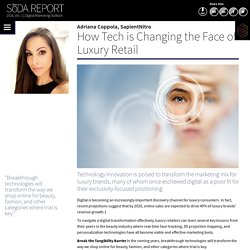
" "Just as beauty brands have begun to shift from product to service, luxury retailers should also plan to compete in this realm by providing curated services – enabled by technology. " Adriana Coppola, SapientNitro Technology innovation is poised to transform the marketing mix for luxury brands, many of whom once eschewed digital as a poor fit for their exclusivity-focused positioning. 5 Trends Defining the Luxury Retail Market. The luxury retail market is evolving and during the last decade has seen continuous growth as a whole, even during the times where the global economy has faltered.
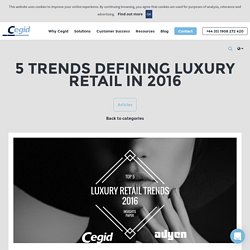
However not all niche markets within the sector have been successful and some, such as leather goods, have noted a drop in sales. Despite this, consumers are showing that they are making provisions in order to still be able to attain the luxury products they desire. Seven Brands Changing America's Retail Industry With Innovation Labs. At first glance, Westfield San Francisco Centre appears to be a typical American shopping mall with the usual rotation of mass-market retailers, a food court and a movie theater.
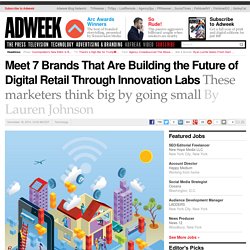
But perched on the top level is an office most shoppers probably don't know about that’s designing the next generation of retail, bearing little resemblance to the current setup. A row of glass windows tucked into the side of the mall houses Westfields Labs—the digital arm of Westfield Group, which owns and operates more than 40 shopping malls globally. The lab is tasked in rethinking how today’s consumers shop while plugged into their mobile phones and social media accounts. Luxury brands focus on innovation and design to target millennials. The next time you decide to pay top dollar for a handbag or pair of shoes that carry the prestigious "Made in Italy" label, you might want to take a moment to consider that maybe it wasn't.
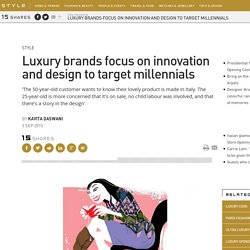
This is because that if most of the bag was made in a factory in Portugal or Guangdong, and then shipped to a workshop in Tuscany where the handle was stitched on, by rights it is considered a "Made in Italy" product, according to the European Customs Code, which oversees the legality of labelling. The subject is rising to the forefront of discussions about luxury retail at a time when anecdotal evidence is proving that a wide swathe of shoppers couldn't care less about where something is made. "The 50-year-old customer wants to know their lovely product is made in Italy. A product, even if it has been made in two or more countries, is considered to originate in the country where the final work took place. "But that older consumer isn't as in touch with the brand as millenials are. Are Luxury Brands Disrupted by the Digital Revolution? By Denis Morisset The Digital Revolution has changed the business landscape significantly, transforming the ways in which brands reach out to consumers and how consumers interact with brands.
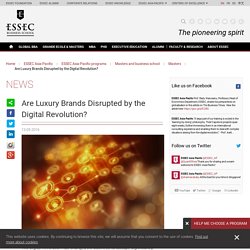
Being present on digital channels has thus become necessary for brands to continue engaging with their customers effectively. An often-asked question then comes into consideration: Does this apply to the Luxury industry, where exclusivity is seen as a key element of value to brands? Retail Innovation. Forbes Welcome. Forbes Welcome. 6 Key Luxury Trends That Will Make Or Break Brands In 2016. Welcome to 2016.
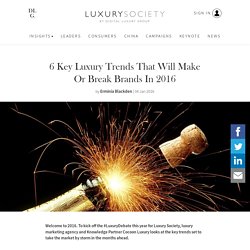
7 Digital Innovations for Luxury Brands. Luxury brands must innovate or die in the digital age.
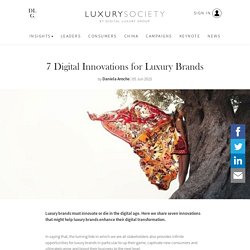
Here we share seven innovations that might help luxury brands enhance their digital transformation. In saying that, the turning tide in which we are all stakeholders also provides infinite opportunities for luxury brands in particular to up their game, captivate new consumers and ultimately grow and boost their business to the next level. The key to this, without doubt, is innovation in all its forms. Innovative strategies, products and communications have the unbridled ability to foster loyalty, build brand value, encourage and alter purchasing behaviours – and even, engage the increasingly jaded millennials set which are becoming today’s early adopters and influencers. “ Brands must give consumers what they want, before they know they want it ”
Cohort 3 Companies - XRC Labs. XRC Labs - Accelerating Innovation In Retail And Consumer Goods. Retail Lab Technology. Retail Innovation. New Lab – A multidisciplinary design & technology center. Hybrides rechargeables.